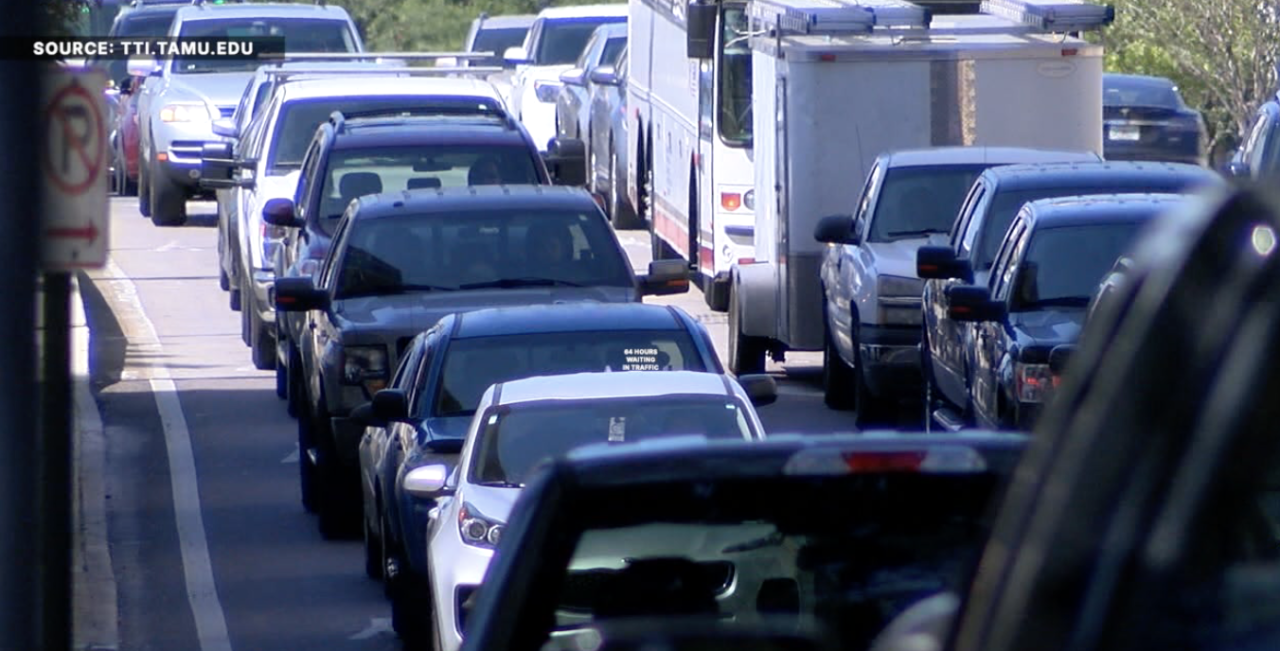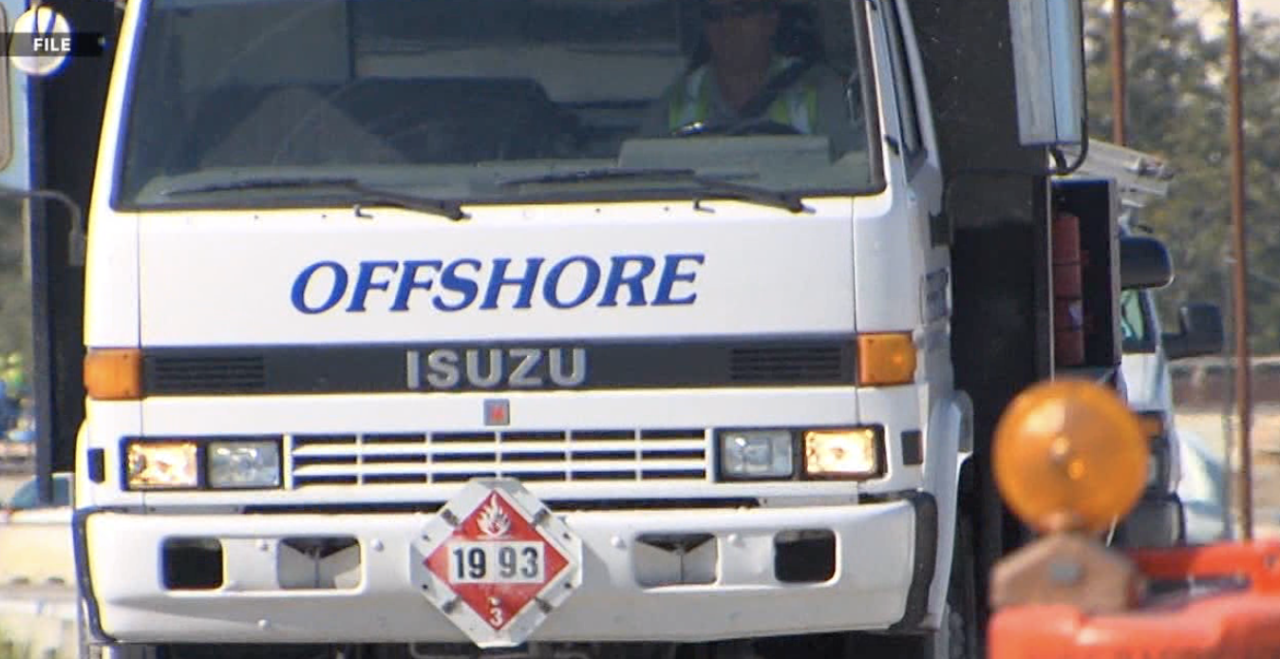TAMPA, Fla. — What can you accomplish in 64 hours? You could watch about 32 movies, listen to more than 1,000 songs, read several books, learn a new skill, or spend quality time with family and friends. It only takes about 63 hours to drive from Tampa to Skagway, Alaska.
Instead, Tampa Bay drivers spend those 64 hours each year sitting in traffic, staring at brake lights, and feeling their frustration mount.
WATCH: What could you do with 64 hours? Tampa Bay drivers lose that time yearly to traffic
The Tampa-St. Petersburg area ranks 20th among 101 urban areas nationwide for total traffic delays, with commuters collectively wasting 112,436,000 hours in 2024, according to the 2025 Urban Mobility Report done by Texas A&M Transportation Institute. That represents a 7% increase from 2023, showing the problem is getting worse.
Those 64 hours per driver equal more than eight full workdays or an entire week of vacation time lost to gridlock annually. The collective 112 million hours lost could power thousands of businesses or fuel countless personal pursuits across the region.
But the patterns of when people get stuck have dramatically shifted since COVID-19, creating new challenges for commuters and transportation planners alike.
For the first time since researchers began analyzing travel data, Thursday has become the worst day for traffic delays, overtaking Friday as the most congested day of the week.
Tampa Bay 28 reporter Jada Williams spoke with one of the research scientists featured in the report.
"It has been an increasing trend since we have come back from COVID," said Kartik Jha, a researcher with the Texas A&M Transportation Institute who authored the mobility report. "For the first time, actually, Thursday has the highest delay of the week instead of Friday."
The Tampa-St. Petersburg area ranks 30th nationally for delay per commuter, with congestion lasting 4.7 hours each day across the metro area. Traffic delays are split between city streets and freeways, with 35% occurring on city streets during peak hours and 30% on freeways during rush periods.
Residents say they feel every minute of those delays, which represent time that could be spent on countless other activities.
"I could be getting more hours at work. I could be spending more time with my kid, but I gotta sit in traffic half the time," said James Mengersen, who moved to Tampa six months ago from Pasco County for work opportunities. "Jeez, that's too much. Ain't nobody got time for that."
Mengersen said those 64 hours could mean "spending a lot more time with my kid, like maybe going to the park a lot more."
Traffic congestion affects both daily commutes and the quality of life of Tampa Bay area residents. Mengersen said he's been nearly hit by vehicles six times while walking to work, highlighting safety concerns beyond just time delays.
"People don't pay attention out here to people walking. People don't even pay attention to you when you're driving," Mengersen said. "Tampa traffic is terrible."
Taylor Williams, who lives downtown, said the 64-hour figure "sounds about right" based on his daily observations of the worsening conditions.
"When I go to work, and I leave downtown Tampa, you see just standstill traffic coming in," Williams said.
"64 hours is more than a single day, it's more than two days, it's absolute waste of time. There's better ways for me to spend my time than sitting in traffic," said AJ Patsios.
The shift to Thursday as the worst traffic day reflects changing work patterns as more people embrace flexible schedules, remote work and hybrid arrangements. While Friday still sees the highest volume of cars on the road, Thursday now experiences the worst delays because commuters are less flexible with their schedules mid-week.
"Those people and cars are traveling during different, more flexible parts of the day" on Fridays, Jha said. "Maybe they're leaving early from work to go to, maybe they're taking an extended weekend, or they can remote work for the rest of the day on Friday."
Tuesday, Wednesday, and Thursday now see more commute-focused travel than Fridays, as workers save their flexible arrangements for the end of the week.
Another major change is increased travel during midday hours, from 10 a.m. to 2 p.m., which were previously less congested before the pandemic. Remote workers and people with flexible schedules now run errands and travel during these traditionally quieter periods.
"More people are traveling during those hours and days of the day and the week," Jha said. "People are traveling during the middle of the day around from 10 a.m. to, let's say, 2 p.m., or those 4 or 5 hours, which used to be less congested earlier before COVID."
This shift has created both benefits and challenges. While spreading demand throughout the day reduces some peak-hour congestion, it also makes traffic patterns less predictable.
"The same transportation system is able to cater to a lot more demand during other parts of the day, which were less utilized earlier," Jha said. "But you just don't know how much demand and traffic you're gonna see, even if you leave at 1 p.m. from the office. You are probably going to see more traffic now than we used to before COVID."
The unpredictability means even off-peak travelers must build extra time into their schedules, further eating into those precious 64 hours that could be spent elsewhere.
The 7% year-over-year increase in delays reflects Tampa Bay's continued population growth and infrastructure challenges. Many residents live in outlying areas and commute into the city center for work, creating bottlenecks during rush hours that now extend beyond traditional peak periods.
"We don't have the infrastructure needed for the amount of people that are here anymore," said Camden Mitchell, a local resident. "The highways definitely need to be widened."
Despite ranking in the top 30 nationally for per-commuter delays, residents suggested several potential solutions, including expanding public transportation beyond the current trolley system and creating rail connections between major areas like St. Petersburg and Tampa.
"There's no reason the trolley can't go to more destinations than just downtown," Williams said. "Also being like a train system, like going from St Pete to Tampa, across the Howard Franklin, if there was like a train in the middle, I feel like would reduce a lot of traffic going across."
Mitchell agreed that public transportation could help reduce the 64 hours annually that drivers lose to congestion.
"Public transportation can be great and can be super efficient and makes life easier," Mitchell said. "I think it would be more convenient for us to actually get around."
Jha said solutions require a combination of strategies, including low-cost operational improvements, targeted capacity expansions, technology integration, and better signal timing on arterial roads.
"It's a very interesting time because it used to be a lot about lane expansions and multi-million dollar improvements," Jha said. "But now you can also get a good bang for your buck focusing on those operational strategies so that you can get more out of your existing system."

These operational improvements could include better traffic signal timing on arterials and strategic use of reversible lanes to respond to changing travel patterns throughout the day and week.
Despite the frustration with losing the equivalent of more than a week's vacation time annually to traffic, many drivers have adapted by finding ways to be productive during their commutes.
"I either will get on the phone with, like, catch up with family members while I'm sitting in traffic, listen to a podcast," Williams said. "I just like, in Zen, like, I'm like, whatever, we'll get there eventually."

Pitsios said he spends about 90% of his driving time on phone calls for work or personal matters, or listening to audiobooks.
"I find ways to be productive. I find ways to get things done that I need to get done," he said. "You have to find ways to be productive."
But the adaptation doesn't eliminate the fundamental loss of time that could be spent on more meaningful activities.
"I used to be like, all like, oh, this traffic sucks. But now I'm kind of like, I either will get on the phone or just try to do things like that," Mitchell said. "But it is frustrating, don't get me wrong, but you just kind of have to accept it."
Share Your Story with Jada

Jada Williams is focused on the issues that matter most to people in Hillsborough County. From downtown Tampa to Apollo Beach, Jada works to bring you updates and solutions on everything from crime to infrastructure. Reach out to Jada below with your concerns for your neighborhood.
.

Missing beehives returned to 84-year-old Florida beekeeper after story goes viral
Richard Marquette lost 20 beehives in July when someone mistakenly cleared his property, taking away his primary source of income from honey sales.





